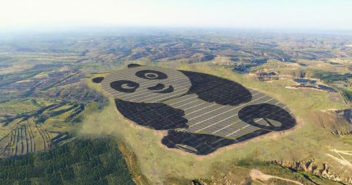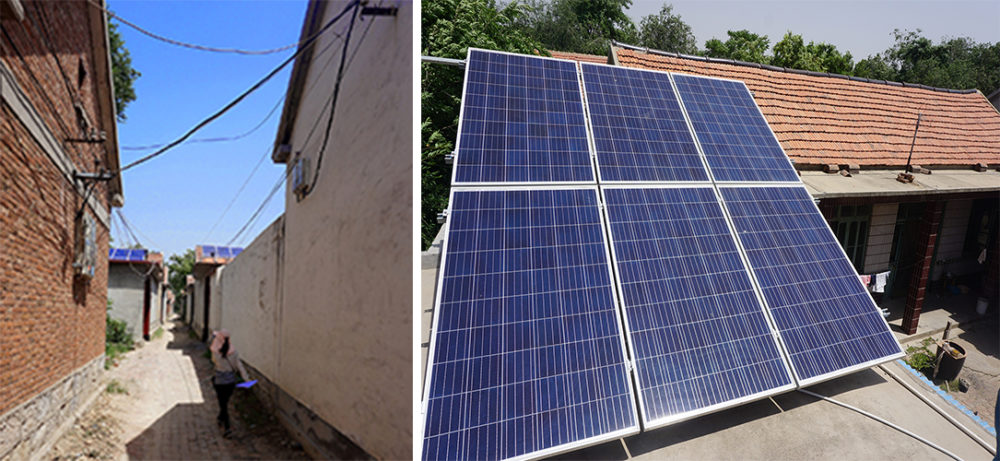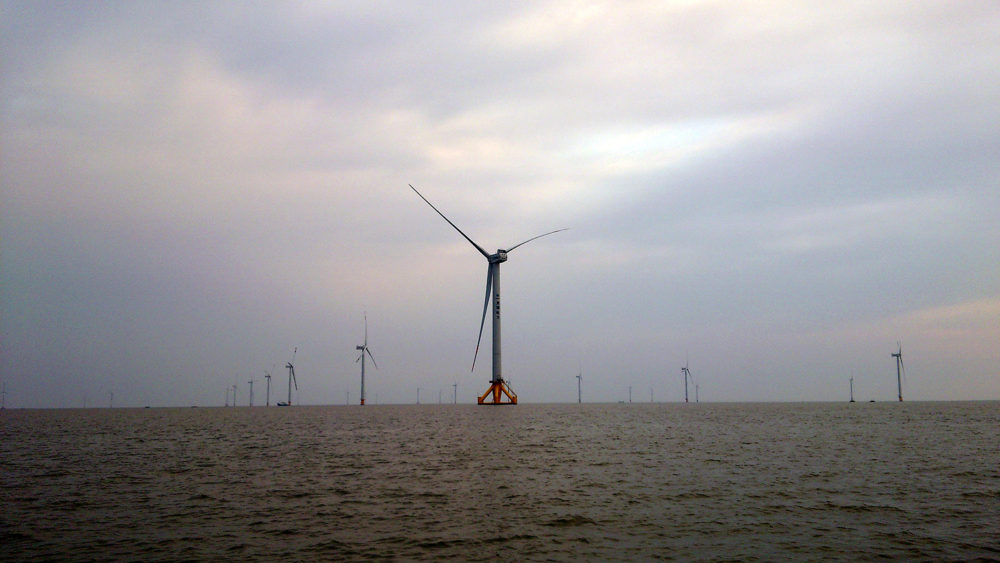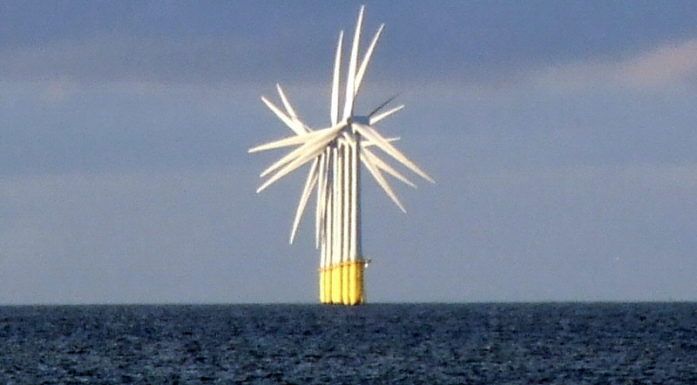China’s rapid development of solar and wind power
Chinese authorities are investing heavily in green energy. The country has become a world leader in solar and wind power. This rapid expansion was made possible by the approach taken by authorities.
China accounts for 30 per cent of the world’s greenhouse gas emissions, of which a large share comes from coal power. It’s an established fact that if the world is going to reach climate targets, China will need to replace a large percentage of its current power mix with renewable energy.
Coal power still makes up the largest share of the country’s energy supply by far, but a lot has happened in the field of renewable energy development in a short amount of time.
“China is now a world leader in renewable energy, both in terms of producing and using renewable power. China has taken the lead in solar and wind energy in particular,” says Marius Korsnes.
Korsnes is a researcher at NTNU and has spent the last decade studying the development of renewable energy in China. Just before the end of 2019 he came out with the book Wind and Solar Energy Transition in China.
The book sheds new light on how China’s renewable industry has evolved and what management methods the government uses.
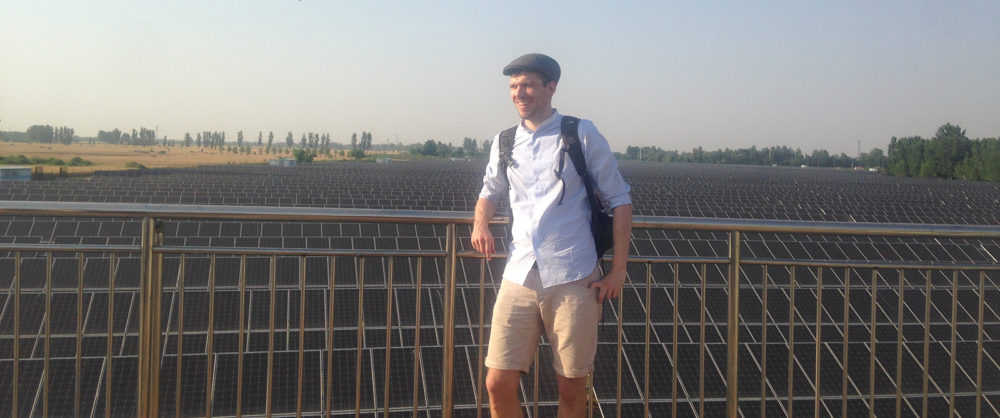
Marius Korsnes stands in front of a solar cell plant in China during one of his study trips to China. Photo: Private
Willing to experiment
Korsnes has investigated what factors have made it possible to build out a new energy system so quickly. He also provides insight into how change is managed strategically in China.
The authorities’ distinctive management approach enables them to orchestrate and oversee innovation and development in wind and solar systems.
“The willingness to experiment permeates the entire Chinese system,” says Korsnes.
Authorities develop pilot projects in a designated area, and policy-making often begins as a small experiment – which then gets scaled up if the experiment proves fruitful.
“A lot of reasons contribute to why Chinese actors seem to be successful in various enterprises, like their wind industry efforts,” says Korsnes, “but I want to highlight how the Chinese government has managed to facilitate learning. At the same time they’ve avoided development slowdowns due to overproduction or because the technology is too expensive or of poor quality.”
Korsnes is a postdoctoral fellow at NTNU’s Department of Interdisciplinary Studies of Culture and heads up research area 1 in FME NTRANS on Norway’s energy and climate change.
The Norwegian Centre for Energy Transition Strategies (NTRANS) is researching the role of the energy system in the transition to zero emission communities.
Good access to electricity is a symbol of development
Industry in China is experiencing vigorous growth and the country’s electricity consumption has grown tremendously over the last 20 years.
“The country has struggled to keep up with the demand for electricity, because electricity consumption has increased so quickly. Investment in industrial development and the rapidly growing commodity production have dramatically increased the need for electricity,” says Korsnes.

Many Chinese now have a better standard of living, and so consumption has gone up. Photo: Idun Haugan / NTNU
“The fact that a lot of Chinese now have a better standard of living also contributes to the increased consumption,” he says.
Korsnes emphasizes that the Chinese authorities are focused on ensuring that people have good access to electricity.
“Electricity is an important pillar of modern society and a symbol of development. A key objective of the Chinese Communist Party is to provide people with access to enough – and affordable – electricity.”
To this end, the authorities subsidize the electric power so that the bill stays low for consumers.
Other world powers have also recognized the importance of power for the people. Lenin, the first leader of the Soviet Union, had as one of his mantras: “Communism = Soviet power + electrification of the whole country.”
Power grid challenges
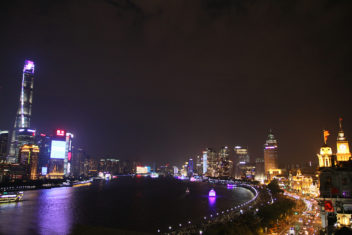
Shanghai’s new district of Pudong stands as a symbol of the country’s strong growth. And loads of electricity is needed here to run the new district. Photo: Idun Haugan / NTNU
The increased production and consumption have created major challenges for the Chinese power grid, which was originally set up for lower power consumption and for a steady power supply from the coal power plants.
With power from the sun and wind, the energy supply varies according to weather conditions and seasons.
“China has the world’s largest power grid, which they’ve upgraded and expanded at record speed,” says Korsnes.
The challenges with the power grid and how the authorities are working to adapt conditions to the new reality are part of what he has studied in his latest research project.
“Renewable energy only produces electricity when the wind blows or the sun shines, so suddenly the power grid has to be transformed to adapt to an uneven supply of power. This is a huge challenge. In Europe we’re also struggling to integrate renewable energy into the network,” he says.
Laws and regs adapted to needs
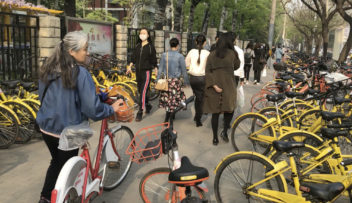
The rental bike trend in big cities like Beijing has accelerated at rocket speed. China now faces the challenge of figuring out what to do with the huge number of discarded bicycles that the bicycle wave brought with it. Photo: Idun Haugan / NTNU
China solves these challenges through the way policy is implemented; the authorities address challenges and problems and find solutions by using both formal and informal tools, Korsnes says.
“It’s all about facilitating process, and this is where the Chinese authorities are flexible and adapt the regulations along the way. For example, they might introduce a new law that’s fairly ambiguous, and then gradually adjust the legislation and paragraphs. In a lot of ways, this process is practical and effective,” he says.
Solar industry grew on its own
“There’s a big difference between how solar and wind energy have grown in China, and it’s interesting to compare how the country has brought these two renewable energy sources on board in completely different ways,” says Korsnes.
His time in China has included several study and research stays, two in Beijing and one in Shanghai. When he wanted to take a closer look at the development of photovoltaic (PV) plants, the research led him in other directions than he had imagined.
“I’d seen lots of statistics and read a lot about the growth of solar cells. But when I started talking to experts on smart and sustainable cities in China, few of them had heard of neighbourhoods or city quarters that had installed solar cells.
It turned out that many of the solar PV systems being built were large plants that were far away from the smart neighbourhoods being established in megacities like Beijing and Shanghai. This situation amplified the problems of power transmission.
Since approximately 2016, the government has focused on developing more decentralized solar power on rooftops in more rural areas, which has also created local value.
“The growing solar cell industry was not a deliberate and planned effort by the authorities in the beginning. It grew out of the fact that in the early 2000s, small-scale actors saw and took advantage of a business opportunity, despite the lack of any government support schemes to stimulate their development.
Government support helped
Then came the financial crisis in 2008. By then, the solar cell industry had become large enough that the Chinese central authorities stepped in and made sure this new industry did not fail. The Chinese solar cell industry thus managed to survive the economic upheaval that caused the whole world to tremble.
Until 2009, China exported almost all the solar panels they produced. But gradually, more and more were installed at home, and the country began both to produce and use solar energy.
“The solar industry took off in 2014, and growth has been exponential. Solar power production is now almost as extensive as wind power,” says Korsnes.
“The rapid growth is largely due to the fact that the authorities have managed to establish solid support schemes. At the same time they’ve had to find a balance so that the support schemes do not become so good that they expand too much too fast. They seem to have found a balance that’s working.”
Wind power took off — but too fast
On the wind power side, development has occurred completely differently from solar energy. The wind power initiative began when China started to import the technology from other countries, including Denmark and Germany.
Little by little, China took over the production of wind power plants and components.
The country started to take an interest in wind as early as 2002, but the growth started in earnest in 2008.
“Since then, the wind power industry has been developing fast. Too fast,” says Korsnes.
Starting in 2011, Chinese authorities have reduced the aid schemes to limit development. Too many wind farms were being built quickly and the power grid didn’t have the capacity to use all the electricity being generated .
Wind boom
During the Chinese onshore wind industry boom between 2008 and 2011, several signs indicated that development was happening too fast. More turbines were being built than sold, and many of the turbines were not connected to the power grid.
The development of wind power during this period had been decided at the local level, with a maximum project limit of 50 MW. Local authorities who wanted to make the most of the new industrial venture were “smart” and approved several projects of 50 MW right next to each other.
This led to huge project footprints, something that the national authorities had not foreseen.
The development of the power grid is regulated at the national level, and the power grid wasn’t sized to receive so much power at once. This resulted in many of the turbines not being able to deliver the power they produced.
The central authorities decided in 2011 that the NDRC (National Development and Reform Commission) needed to approve new projects. This led to reduced growth in wind power development.
Quality over quantity
To avoid overcapacity and poorly functioning turbines, the governing authorities also modified the criteria for who could win tenders. Previously, cost had been an important criterion, but now experience, the degree of locally produced parts and technical plans became important criteria.
“These are some of the measures that changed the focus from producing the largest possible quantity to an emphasis on quality. The criteria changes are examples of how the Chinese government applies a flexible and experimental approach to formulating and implementing policy,” says Korsnes.
“Taking risks, and at the same time thinking long-term and ensuring flexible policy-making, are qualities that can lead to sustainable solutions for the future being achieved more quickly.”
Many of the world’s largest wind turbine companies are now Chinese.
Wind power in China at a glance
- At the start of 2016, China had installed a total of 145 000 megawatts (MW) of wind power, which is 3000 MW more than all 28 EU countries combined.
- This despite the fact that China only started developing their wind power industry about 30 years later than the first EU countries.
Source: Marius Korsnes. Kina tar vinden i bruk.(2016)
Most of China’s wind power capacity is land-based, but offshore wind is a growing priority industry.
Investment in renewables as a result of financial crisis
China made renewable energy a strategically important industry for China following the financial crisis, and today renewable energy investment receives considerable government support.
“What we’re seeing now in China is a major strategic, state-wide commitment to renewable energy. The state is facilitating renewable innovation,” says Korsnes.
“It’s similar to the Norwegian investment in the oil industry in the 70s. But in Norway, we seem to have forgotten the importance of supporting development and innovation in terms of the energy of the future,” he adds.
World’s largest dam
Hydropower accounts for as much as 18 per cent of China’s total power generation.
China's electricity supply in 2018
- 69 per cent coal, oil and gas
- 18 per cent hydropower
- 5 per cent wind
- 5 per cent solar
- 5 per cent biomass
- 4 per cent nuclear power
Read more at https://chinaenergyportal.org/en/2018-electricity-other-energy-statistics/
Mao’s eagerness to develop hydropower was a major impetus in achieving its prominent place in renewable energy generation. One of his dreams was to build the world’s largest dam. The Three Gorges Dam spanning the Yangtze River was only completed 30 years after Mao’s death, but it is indeed now the world’s largest dam and delivers huge quantities of power.

China’s 2018 energy mix statistics from China Energy Portal. The graph was reproduced with permission from the Norwegian Climate Foundation
Coal receives indirect subsidies
Although renewable energy is growing rapidly, coal still accounts for 69 per cent of the country’s power generation.

The graph compares the distribution of renewable (shown as blue), fossil fuel (black) and nuclear energy (green) sources in Norway, the EU and the USA. The graph was reproduced with permission from the Norwegian Climate Foundation.
Local authorities often want to support coal power because it provides stable income and good tax revenue to the municipality or village. Coal is still benefiting from indirect subsidy schemes such as favourable agreements for power generation and power supplies.
Korsnes emphasizes that much of China’s electricity production, not least that of coal, is used for industry and commodity production and that much of the emissions are so-called “exported emissions”. That is, power is used to produce goods that are exported.
“The West imports a lot of goods from China, so as consumers we also have a responsibility and an opportunity to wield influence. For example, we can demand that the goods be manufactured using renewable energy sources,” says Korsnes.
More info on China’s coal power in this article from Wired.
References:
- Korsnes, Marius: Wind and Solar Energy Transition in China (2019).
- Korsnes, Marius. Kina tar vinden i bruk. (China puts the wind to use).
- China’s green revolution. Hva skjer på klima- og energifeltet i Kina – og hvorfor?(What is happening in the climate and energy field in China – and why?) (2016). Norwegian Climate Foundation
